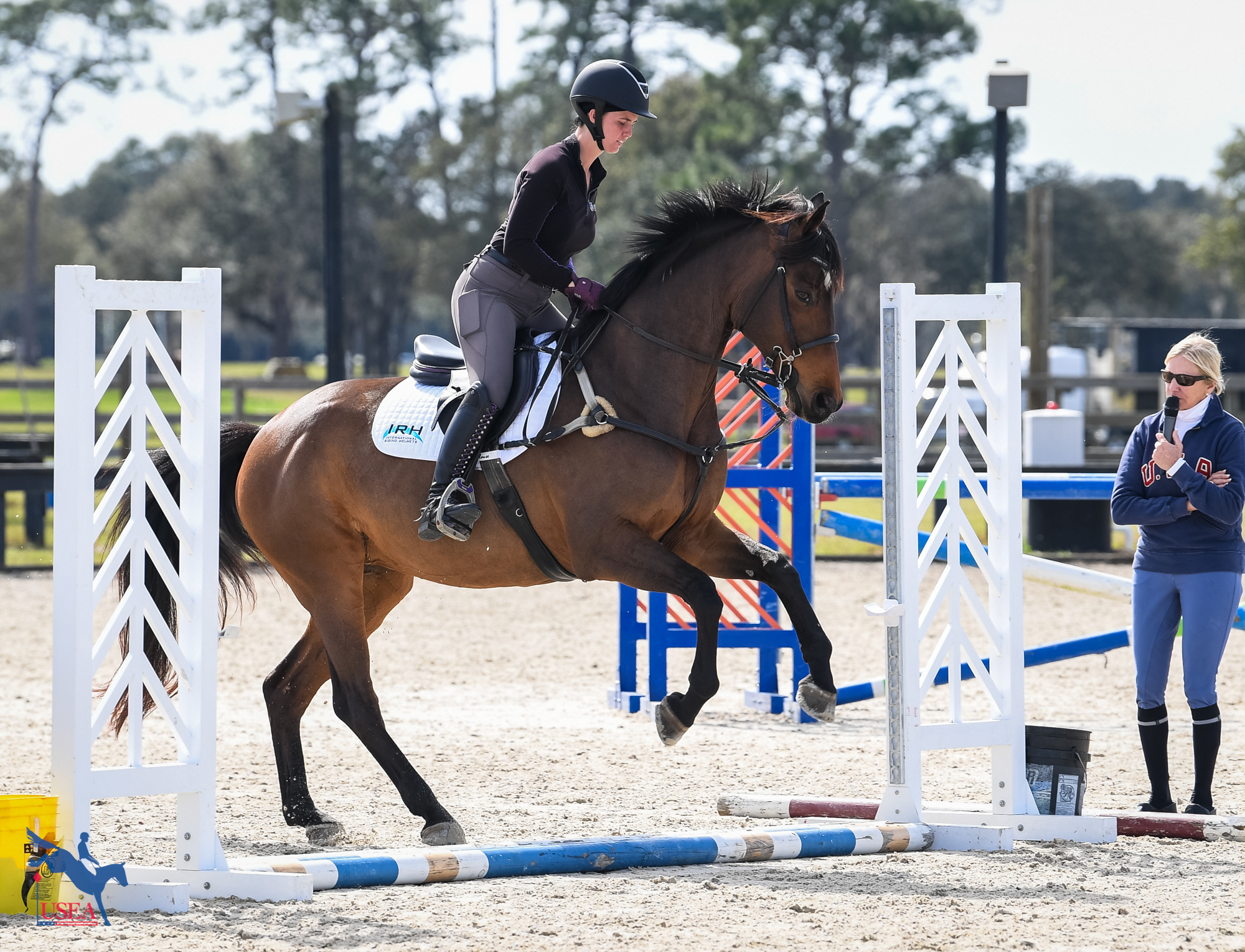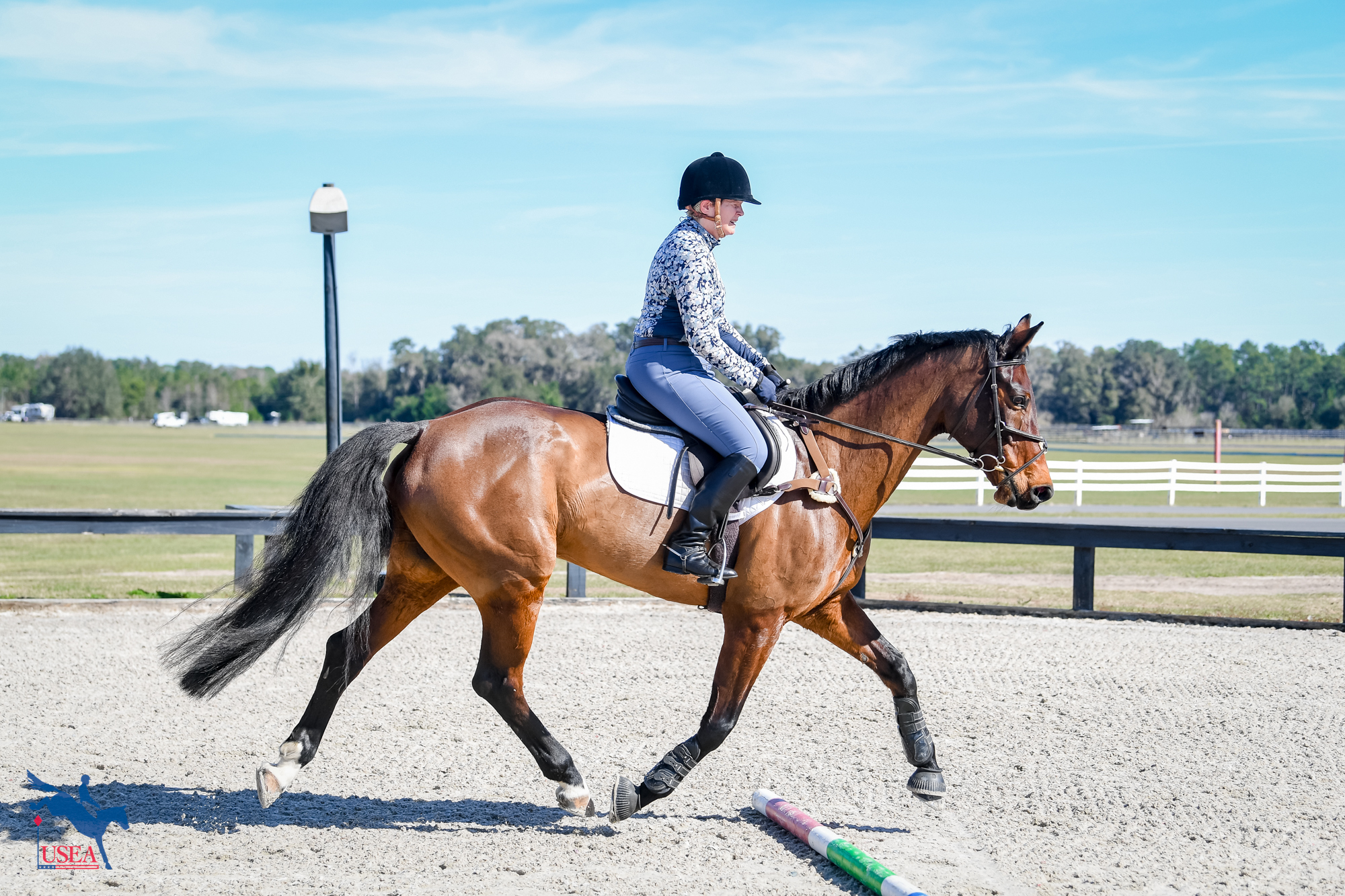Creating Engagement in the Canter on Day 3 of the 2024 ECP Symposium

Ocala, Fla.—Feb. 1—The final day of the USEA Eventing Coaches Program (ECP) Symposium was all about show jumping, but as event riders know, proper flat work is the key to better jumping.
As with the previous two days, participants broke into groups with ECP coach mentors to observe demo riders from Beginner Novice through Intermediate, then come up with a lesson plan that included a few key points to work on.
ECP coach Robin Walker kicked off the morning by telling participants that he thinks show jumping training can be the most confusing of eventing’s three phases.
“There’s too much information. You see it all the time in warm ups and lessons,” he said. “I think one of our responsibilities as coaches is to know what we want to see and how we want it to end up. Are we sure we know our distances? Are we sure we know how that varies between schooling and competition? Are we actually confident about what we’re trying to teach? Most of us don’t know what we’re trying to teach. Most of us don’t teach 1.40-meter riders. I’d like you to all consider that in your own minds, not just today but when you go back. Consider what your end game is, and how am I going to get there?”
Karen O’Connor, who led yesterday’s cross-country lecture by talking about the three cross-country positions, described the three show jumping positions—the sitting or full seat, used when coming to a jump, the standing position, used when going forward, and the close contact or half seat, which takes the most balance.
The discussion and subsequent riding sessions focused on finding the right balance in the canter to the jumps, whether it was using poles on the ground or circles in between fences to get the horse to engage, all while being mindful of the rider's three positions in the saddle.

For Jennarose Ortmeyer and her Preliminary mare Primrose, engagement, throughness, and lateral flexibility was the big note from Walker’s group. During the warm up, Primrose didn’t have smooth flying changes, so O’Connor and Walker worked together with the pair first on the flat on a small circle to get the engagement, making sure Ortmeyer gave with her hands instead of holding the mare tight. Then they worked on circles in front of and after a pole to get a clean change, followed by gradually working in jumps with circles in front of and after.
“There’s three ways to engage a horse—downward transitions, small ring figures, or lateral work,” said O’Connor.
By the end, the pair was jumping smoothly over an oxer to a 90-degree turn to a vertical.
“I think when you walk courses, don’t think about how big the jump is or the number—the meat of the course is what happens between the jumps,” O’Connor added. “I think we’ve all seen where a horse jumps the first fence OK, then gets a little faster, then really fast, and then something is going to happen—rails down, jumping flat, or at the very worst they’re going to say, ‘I can’t do this.’ We want to never get the horse in that position. I think the navigation that you chose for your horse is critical. Before we get to the jump, the horse has to have his hind end underneath him.”
O’Connor noted that in show jumping, the rider’s back must be flat, as opposed to more of the C shape she described for cross-country.
“Your horse will always emulate your posture,” she said. “Right from the beginning, I think it’s important that you teach your students how to have posture in show jumping and the elements that make the jump good.”
Mary D’Arcy also echoed that sentiment when she added her thoughts to the discussion.
“None of these subjects that we’re discussing are possible without position,” she said. “I’d say 99 percent of the people we’re teaching are deficient in some way—they’re not secure, they don’t have a good balance, they’re stiff, they’re hanging on the horse’s mouth. It makes it difficult to explain if the position is not addressed first as regards to an independent seat and not using the horse’s mouth to balance on.”
She recommended some kind of exercise for the rider off the horse to help with position, such as yoga or Pilates to help create an independent seat that’s secure and supple with good core strength. The rider must be strong enough to work through any weaknesses that the horse has.

Emily Beshear spoke about teaching riders to think of their show jump rounds like a dressage test.
“Everything in the dressage ring is built around what letter you’re going to or your figures, and I think it’s really important, especially at the lower levels, to have that drilled into your students that it’s just as important in the show jumping ring,” she said. “Planning their path makes the jump much easier. The point of the turn is very important. Use it to engage and balance, but also as instructors, realize the variety of ways you can explain it. If you have person get stuck in the turn when they’re sitting down, describe it as more of a flowing turn. You might have two points of turn.”
At the end of the day, ECP faculty member Jennifer Howlett Rousseau summed up the three days of learning and thanked the participants for coming.
“This is about you guys. You are the future and foundation of our sport,” she said. “You are the sales people of our sport, you are the people who introduce people to this sport. You are all treating your students like future Olympians. Congratulations for being here.”
This coverage is brought to you by:

Helpful Links:
- ECP Symposium Fast Facts
- ECP Homepage
- Event Coverage
- Upcoming ECP Workshops and Assessments
- Directory of ECP Certified Coaches
- ECP Certification Information
Don't forget to follow the USEA event coverage on social media!
About the USEA Eventing Coaches Program (ECP)
Coaches are essential to the training of riders and horses for safe and educated participation in the sport of eventing. The USEA Eventing Coaches Program (ECP), formerly known as the Instructors’ Certification Program (ICP), was initiated in 2002 to educate all levels of eventing coaches with crucial training principles upon which they can continue to build throughout their teaching careers. ECP offers educational workshops and assessments by which both regular coaches, Level I through Level V, Young Event Horse (YEH) coaches, and Young Event Horse professional horse trainers can become ECP certified. Additional information about ECP’s goals, benefits, workshops, and assessments as well as names and contact information for current ECP certified coaches, YEH coaches, and YEH professional horse trainers are available on the USEA website. Click here to learn more about the USEA Eventing Coaches Program.
The USEA would like to thank Parker Equine Insurance, the United States Pony Clubs, and Strider for their support of the Eventing Coaches Program.






















